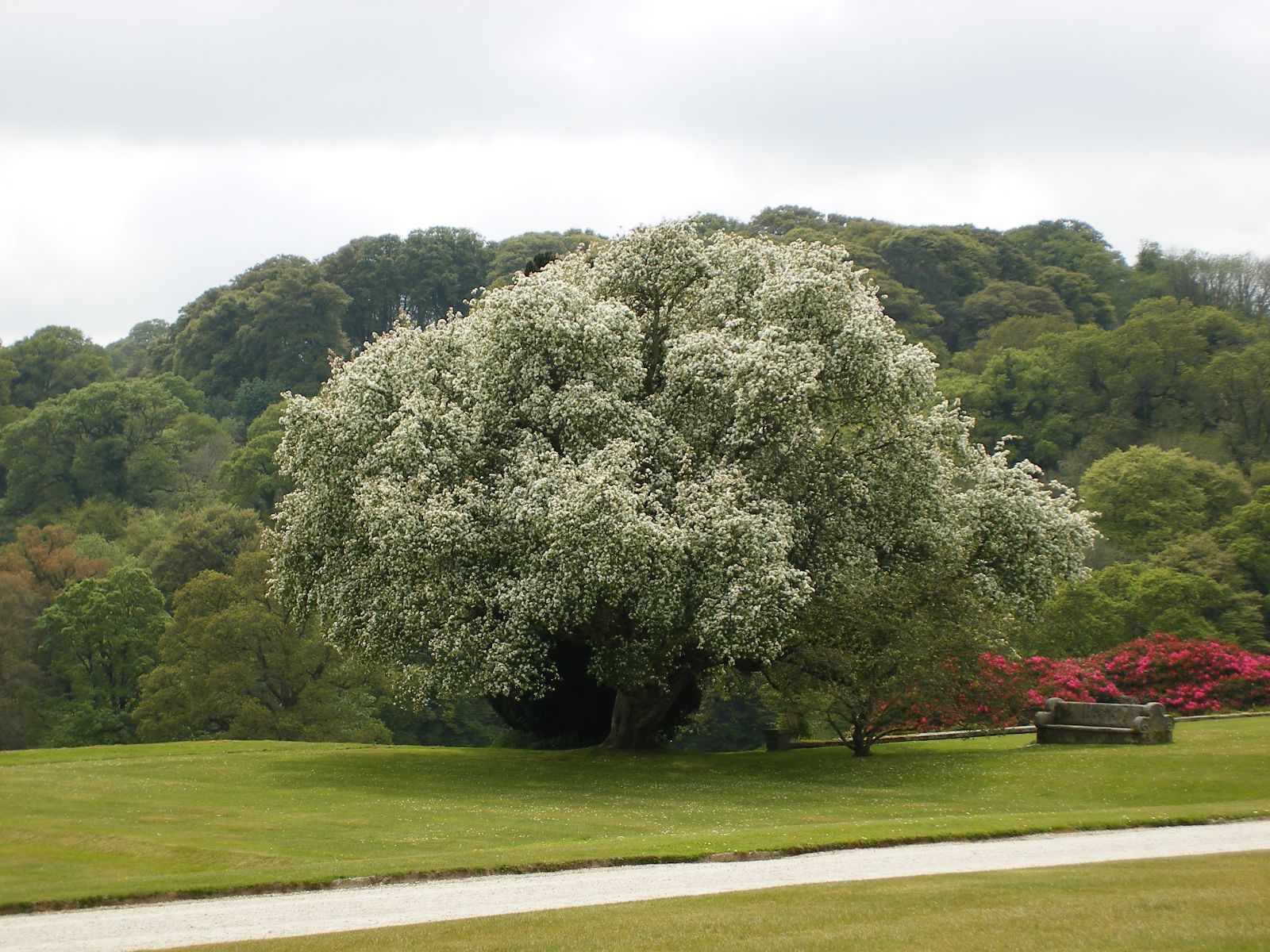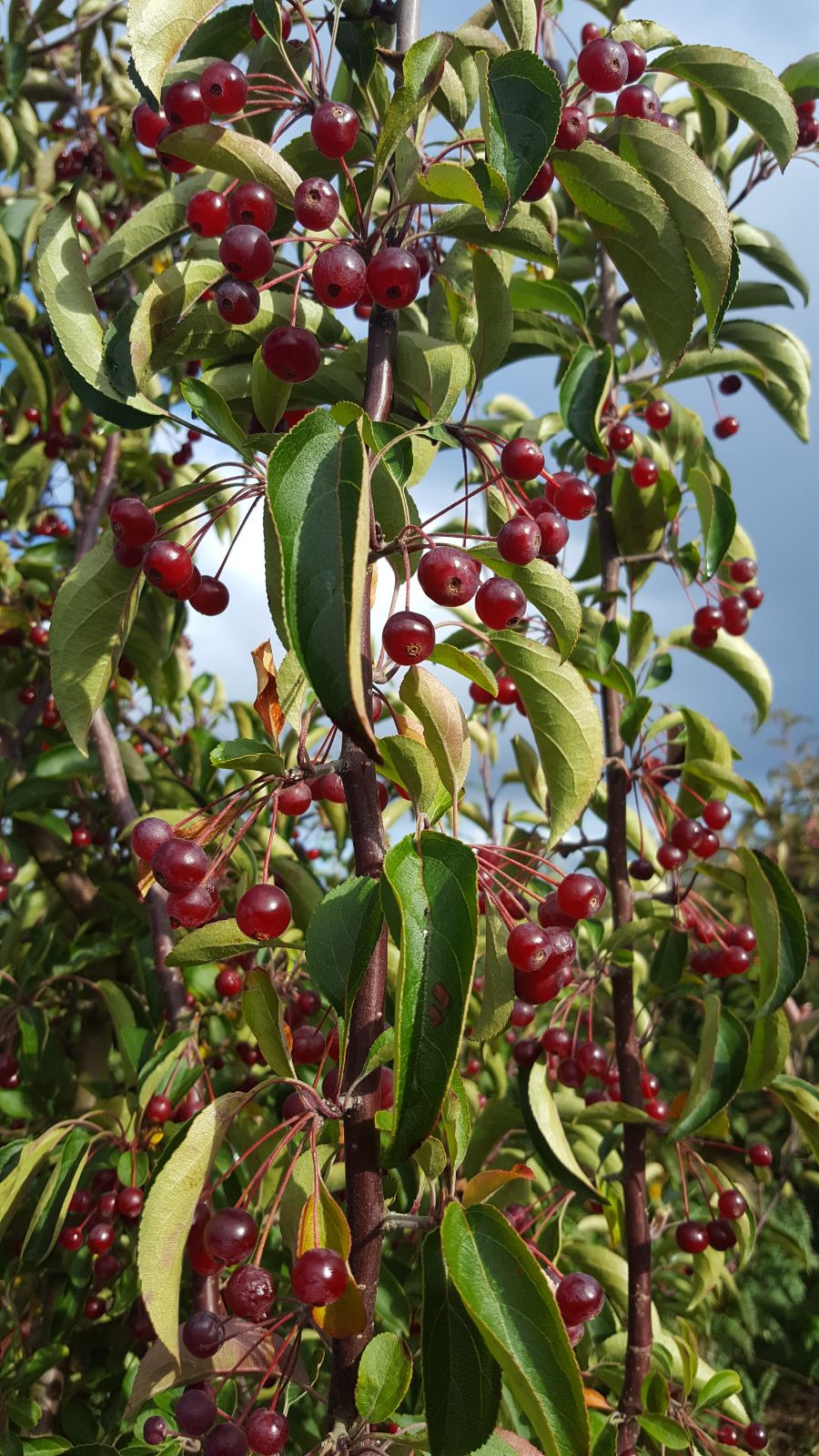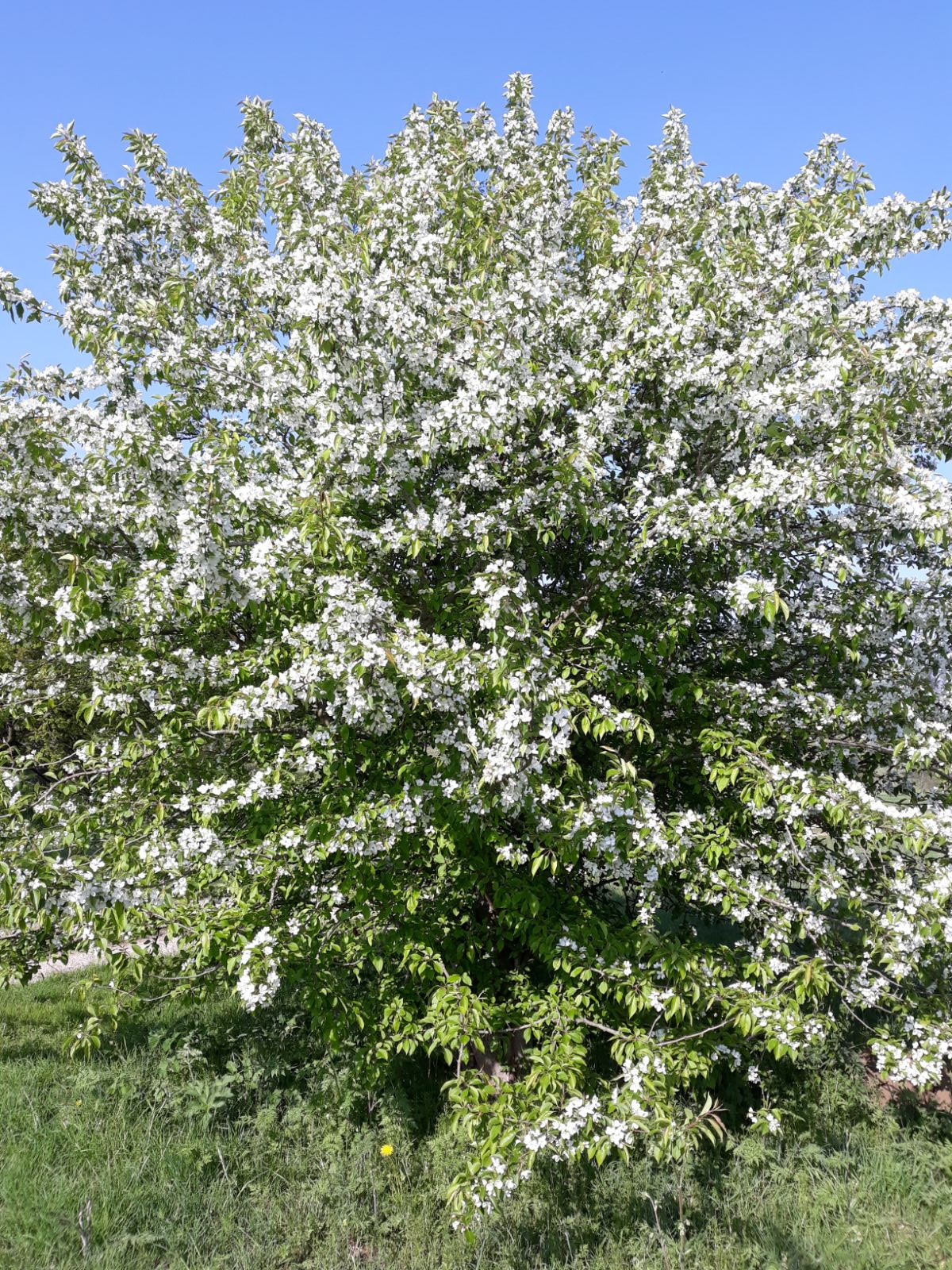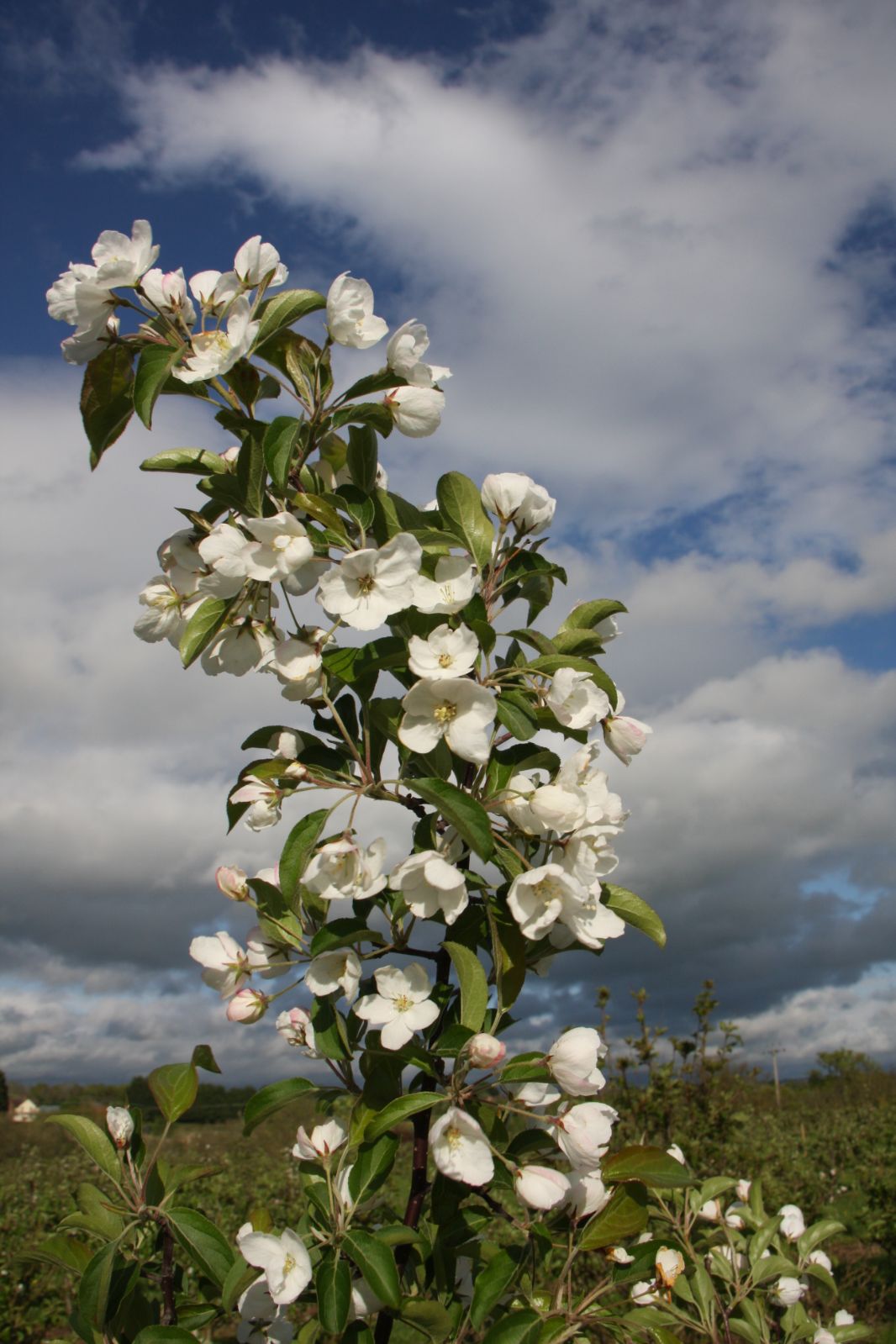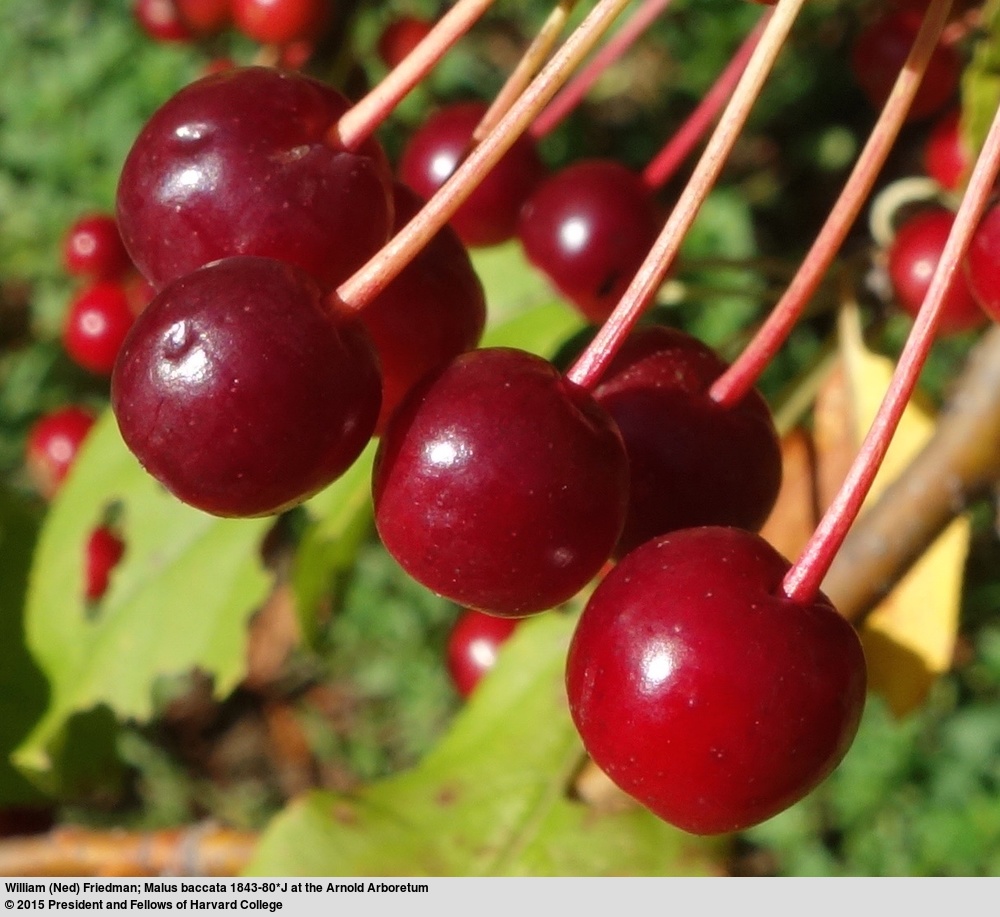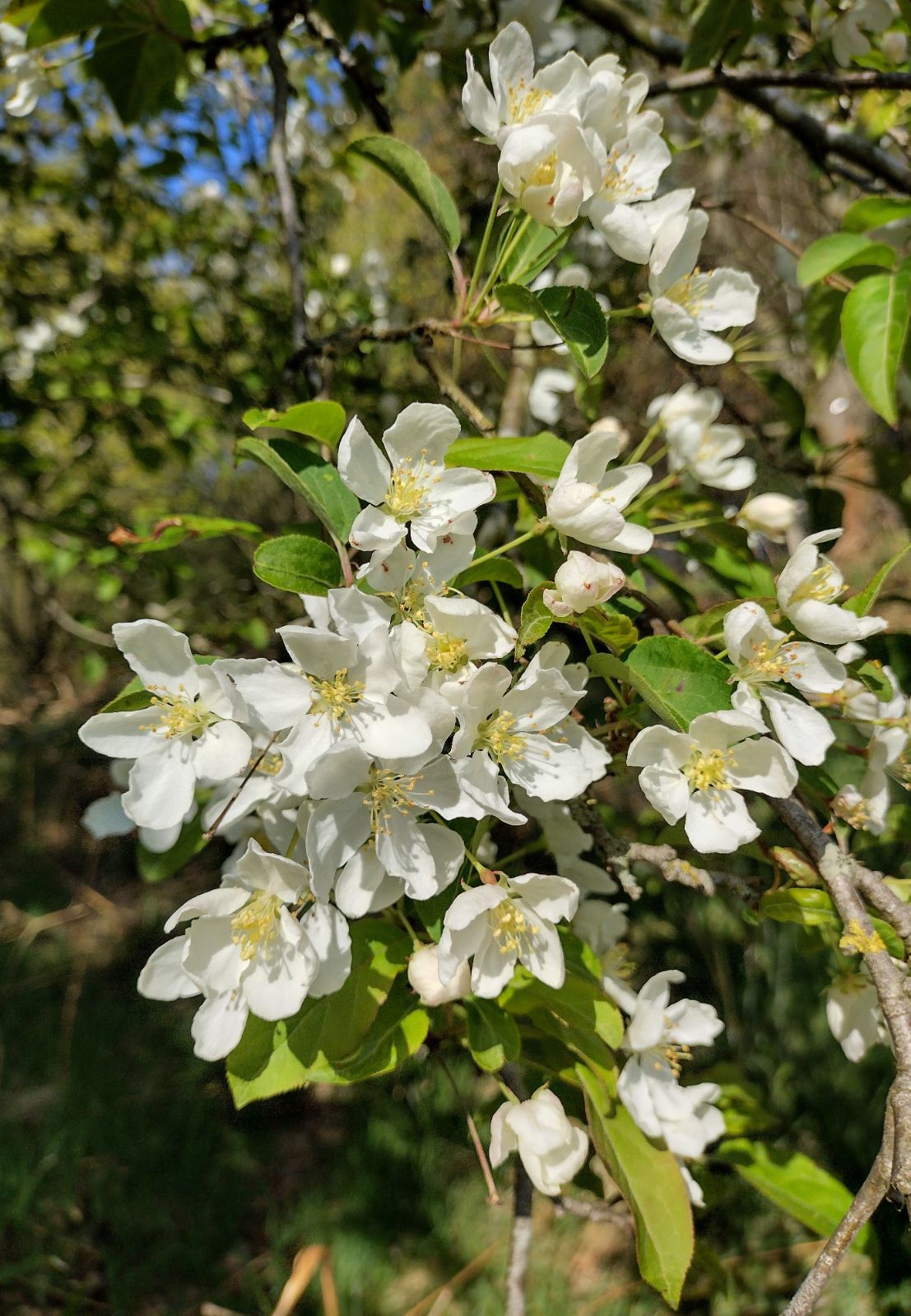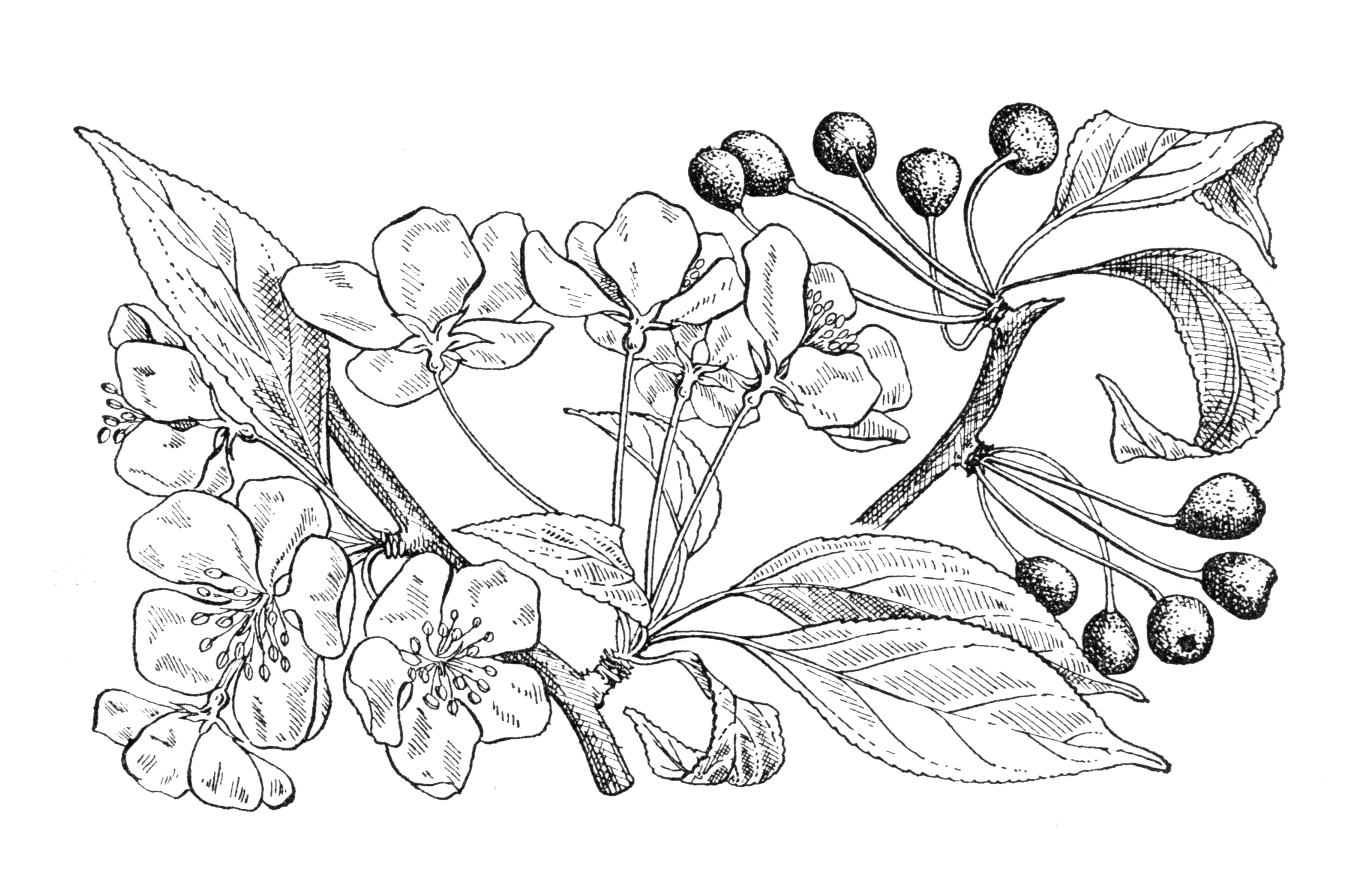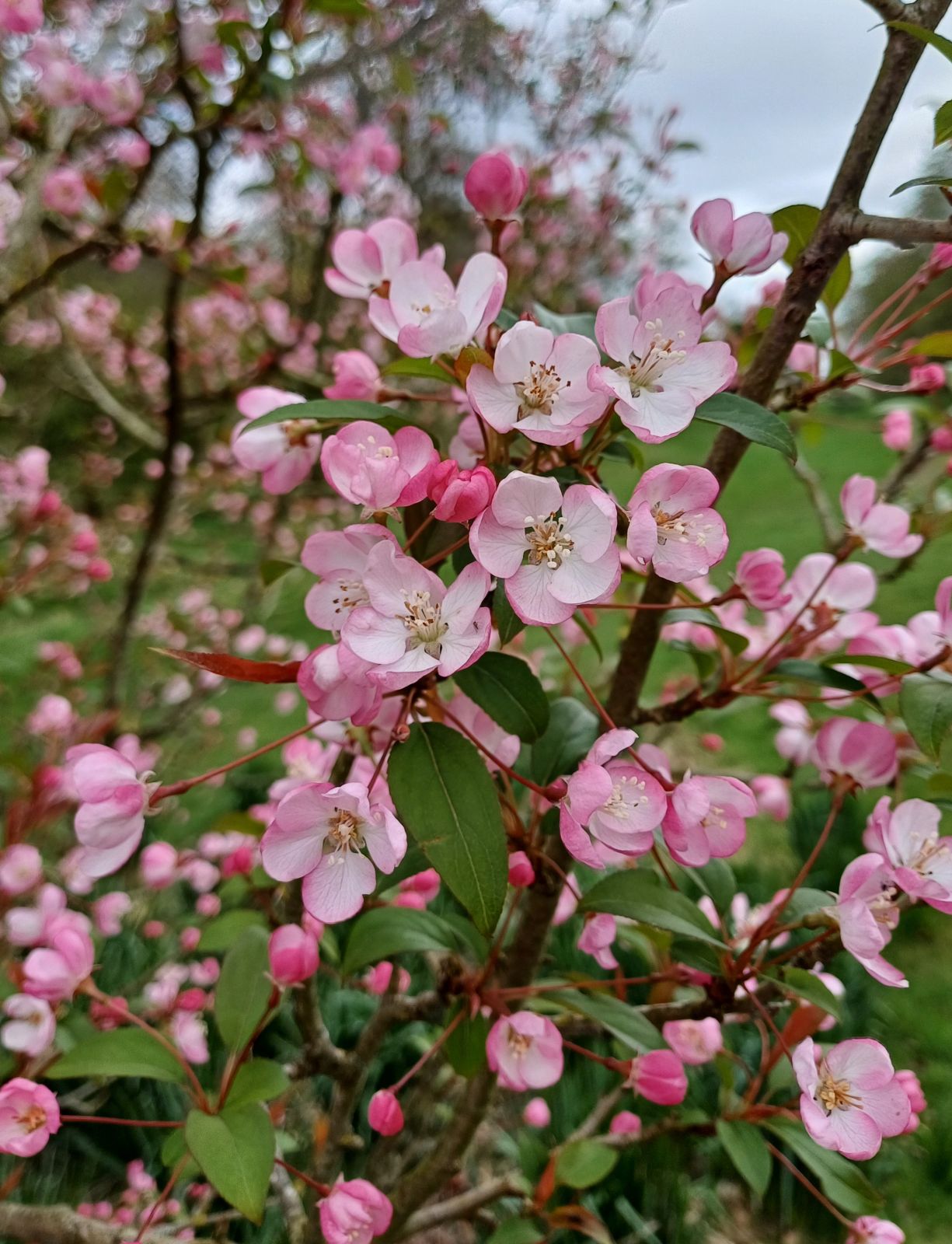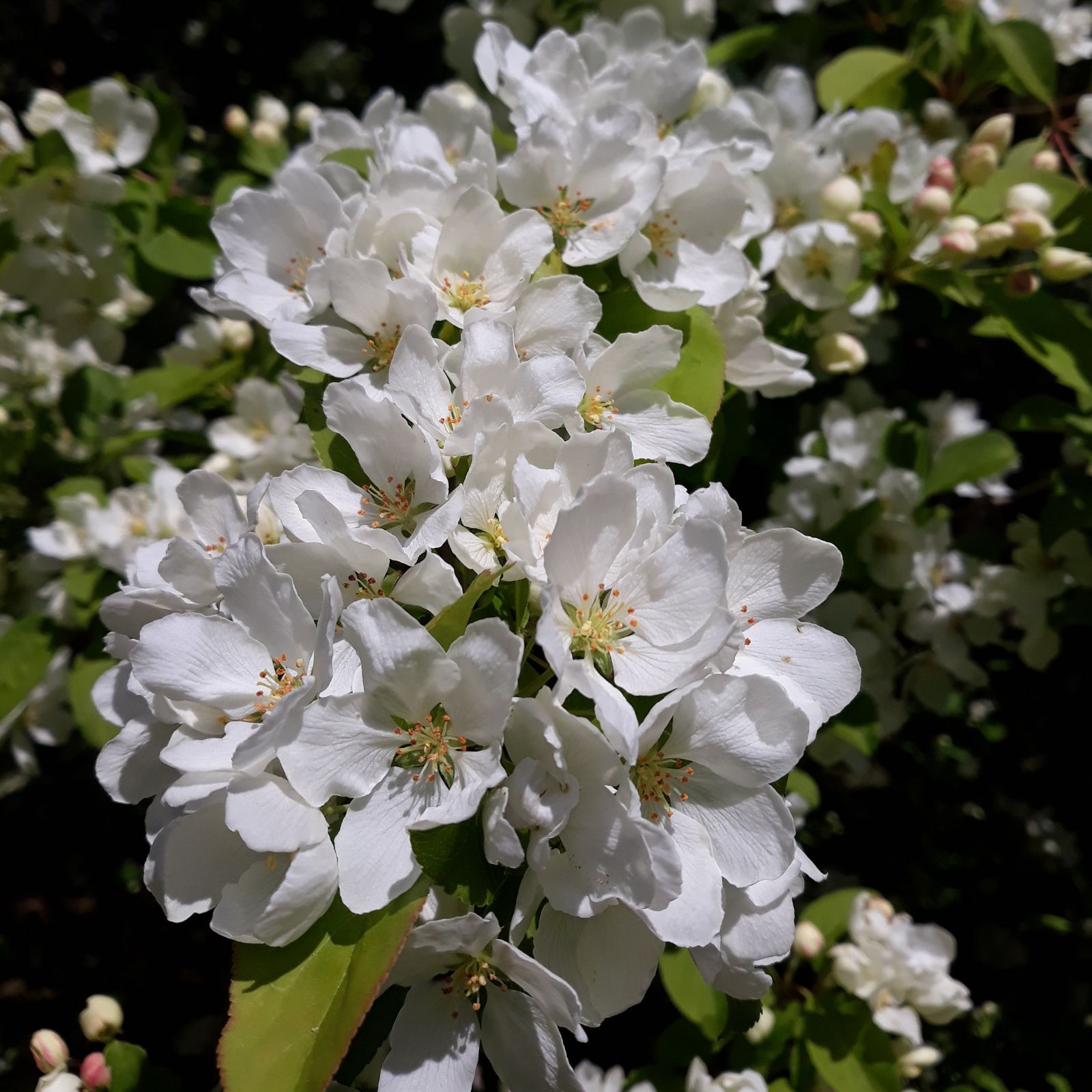Malus baccata
Sponsor
Kindly sponsored by
Francine: 'after many informative Tours and Study Days with the IDS I feel it only fitting to help and promote such a wonderful organisation'
Credits
Julian Sutton (species), Nick Dunn (cultivars) (2021)
Recommended citation
Sutton, J. & Dunn, N. (2021), 'Malus baccata' from the website Trees and Shrubs Online (treesandshrubsonline.
Genus
Common Names
- Siberian Crab
- shan jiang zi
Synonyms
- Pyrus baccata L.
- Malus pallasiana Juz.
- Malus sibirica (Maxim.) Kom.
- Malus sachalinensis Juz.
- Sinomalus baccata (L.) Rushforth
Infraspecifics
Other taxa in genus
- Malus × adstringens
- Malus angustifolia
- Malus × arnoldiana
- Malus asiatica
- Malus × astracanica
- Malus × atrosanguinea
- Malus bhutanica
- Malus × brevipes
- Malus chitralensis
- Malus coronaria
- Malus crescimannoi
- Malus Cultivars A-B
- Malus Cultivars C
- Malus Cultivars D-F
- Malus Cultivars G-I
- Malus Cultivars J-K
- Malus Cultivars L-M
- Malus Cultivars N-Q
- Malus Cultivars R
- Malus Cultivars S
- Malus Cultivars T-Z
- Malus dasyphylla
- Malus × dawsoniana
- Malus domestica
- Malus doumeri
- Malus florentina
- Malus × floribunda
- Malus fusca
- Malus × gloriosa
- Malus halliana
- Malus × hartwigii
- Malus × heterophylla
- Malus honanensis
- Malus hupehensis
- Malus ioensis
- Malus kansuensis
- Malus kirghisorum
- Malus komarovii
- Malus × magdeburgensis
- Malus × micromalus
- Malus × moerlandsii
- Malus montana
- Malus ombrophila
- Malus orientalis
- Malus × platycarpa
- Malus praecox
- Malus prattii
- Malus prunifolia
- Malus × purpurea
- Malus × robusta
- Malus rockii
- Malus Rootstock Cultivars
- Malus Rosybloom Cultivars
- Malus × scheideckeri
- Malus sieversii
- Malus sikkimensis
- Malus × soulardii
- Malus spectabilis
- Malus spontanea
- Malus × sublobata
- Malus sylvestris
- Malus toringo
- Malus transitoria
- Malus trilobata
- Malus tschonoskii
- Malus turkmenorum
- Malus yunnanensis
- Malus × zumi
Usually small tree to 10(–15) m, often with arching branches. Branchlets reddish brown, glabrous. Buds reddish brown, ovoid, scales tomentose at margin. Leaf blade elliptic or ovate, 3–8 × 2–3.5 cm, glabrous or very slightly hairy when young, base cuneate or rounded, apex acuminate, margin serrate; petiole 2–5 cm, with fine hairs at first. Inflorescence a 4–6-flowered corymb, 5–7 cm across; pedicels slender, 1.5–4 cm, glabrous. Flowers fragrant, 3–3.5 cm diameter, in spring (April-June in China, April-May in the UK). Sepals lanceolate, 5–7 mm, tomentose above, falling before the fruit is ripe; petals white, obovate, 2–2.5 cm; stamens 15–20, unequal, about half as long as the petals; styles 5 or 4, longer than stamens. Fruit bright red or yellow, subglobose, 8–10 mm diameter, the type variety with an obscure scar at apex; September-October in China. (Gu et al. 2003; Yuzepchuk 1971; Cullen et al. 2011; Bean 1981).
Distribution Bhutan China Gansu, Hebei, Heilongjiang, Jilin, Liaoning, Nei Mongol, Shaanxi, Shandong, Shanxi, Xinjiang, Xizang India North East North Korea South Korea Mongolia Nepal Russia E. Siberia
Habitat Mixed forests on slopes, among shrubs in valleys; 0–1500 m in China.
USDA Hardiness Zone 2-7
RHS Hardiness Rating H6
Conservation status Least concern (LC)
Malus baccata is the central species in a taxonomically difficult group of small-fruited East Asian crabs. In gardens it makes a round-headed tree with arching lower branches; it has notably early white flowers with a good fragrance, and pea-sized red or yellow fruits (Bean 1981). Disease resistant and superbly cold hardy (Fiala 1994), it can be a long-lived tree: specimens believed to have been planted by Linnaeus at Hammerby, Sweden, in the 18th century are alive and well (Andreasen et al. 2014). The common name Siberian Crab, much repeated in books, is appropriate but confusing: in gardens, the name is more often applied to hybrids belonging in M. × robusta.
This is a very widespread species, ranging from Siberia south to southern China, and from Japan west to the Himalayas. A sexual diploid (Schuster & Büttner 1995), it is very variable. Over the years morphological or geographical variants have been described as varieties, subspecies or even full species. Some are better defined than others, but we lack an overall picture of variation in this group and of how it relates to other similar species: further research is urgently needed (Iketani & Ohashi 2001). We include two widely used names below, at the varietal level (var. himalaica and var. mandshurica) but stress that these are not well defined or perhaps even mutually exclusive categories into which many cultivated plants can easily be shoehorned. Shrubby variants from Sakhalin have sometimes been called var. sachalinensis Kom.; apparently intermediate in hairiness between var. baccata and var. mandshurica (Yuzepchuk 1971), this variety is usually sunk into synonymy with one or the other.
M. baccata sits at the centre of a group of very similar East Asian species with unlobed leaves, including M. halliana, M. spontanea, M. rockii, M. sikkimensis, and M. hupehensis. Their relationships, and even the question of which merit taxonomic distinction, are rather uncertain. There is polyploidy and apomixis within this group and the extent of hybridization is unknown: It seems wise to approach identification within this group in a tentative and open minded way.
M. baccata is a diploid, sexual species (Schuster & Büttner 1995). The first of the East Asian crabs to be named scientifically, it was described (as Pyrus baccata) by Linnaeus in 1767, probably from Russian material (Andreasen et al. 2014), and transferred to Malus in 1803. The specific epithet, from the Latin bacca (a berry) refers to the small fruits. It was introduced to Kew from Siberia in 1784 (Fiala 1994). Stock under this name was already in the British nursery trade (Bean 1981), and Linnaeus’ trees at Hammarby imply an earlier introduction. There have been numerous subsequent introductions from different parts of the range, including two by Farrer (398 and 778) from Gansu; none seems to have made an exceptional contribution to cultivated stocks.
In the British Isles M. baccata is widespread in collections, freely available in the nursery trade and (as the cultivar ‘Street Parade’) marketed for amenity plantings. Bean (1981) notes that in the past specimens of M. × robusta have been misrepresented as M. baccata. Large specimens – we do not attempt to assign these to varieties – include a massively spreading tree at Birr Castle, Co. Offaly, Ireland, measured at 14 m × 286 cm in 2014, and an exceptionally tall one drawn up to 18.5 m in the designed landscape of Newliston, Edinburgh (The Tree Register 2020, the second recorded as M. mandshurica). There is a beautifully formed, spreading tree from a 1966 accession on the Pond Lawn at RBG Edinburgh, 11 m × 228 cm in 2014 (but since retrenched and pollarded – T. Christian pers. comm. 2021) (Royal Botanic Garden Edinburgh 2020; The Tree Register 2020); wild provenance specimens at Edinburgh include several from CLD 335 (Yunnan) and BECX 293 (South Korea).
Widely hardy in continental Europe, it grows well as far north as southern Finland and central Norway (Arboretum Mustila 2020; NTNU University Museum 2020). Frequent in collections, there are specimens of Japanese provenance at both Gothenburg Botanic Garden, Sweden, and the Belmonte Arboretum, Netherlands (Gothenburg Botanic Garden 2020; Belmonte Arboretum 2020).
Long established in North American horticulture, examples of various forms can be seen in collections in the northeastern United States (e.g. Arnold Arboretum 2020) and on the Pacific coast from British Columbia south to central California (University of British Columbia 2020; University of California Botanical Garden 2020). The impressive crabapple collection at the Morton Arboretum, IL, includes multiple specimens of Russian, Korean, and Chinese provenance (Morton Arboretum 2020). M. baccata is well adapted to the cold winters and hot summers of the north-central United States and adjoining parts of Canada; a 10 m tall tree with 12 m spread has been recorded in North Dakota (Herman et al.1996).
Malus baccata is an important parent of cultivated hybrids, notably M. × floribunda and M. × robusta. It is implicated as one source of genes in the soft fruited cultivated apples of Asia, M. asiatica and M. prunifolia (Duan et al. 2017). There is increasing interest in using M. baccata in conventional apple breeding, especially for rootstocks (Volk et al. 2014); a full genome sequence shows that it is particularly rich in genes belonging to families implicated in defence against pathogens and in cold tolerance (Chen et al. 2019). It is itself used as a rootstock for M. domestica and M. asiatica in Northern China (Gu et al. 2003).
While some cultivars have traditionally been assigned to M. baccata, Cornille et al. (2012) showed that in genetic terms many (including ‘Gracilis’) have as much or more in common with M. domestica as with M. baccata.
'Gracilis'
Synonyms / alternative names
Malus baccata f. gracilis Rehd.
A weeping form selected by the Veitch nursery from seed collected in Shaanxi – probably Purdom 329 of 1910, although Veitch gave the number 327 which does not match any Malus voucher specimen (Rehder 1920).
Growth Rate/Size: Medium (<6 m)
Form/shape/habit: Broad and weeping, usually top-grafted
Foliage: Glossy green, smaller than typical M. baccata
Flower colour: White from deep pink buds
Flower size: Large (>4 cm)
Flower form: Single, narrow petals
Fruit size: Very small (<1 cm)
Fruit colour: Yellow-orange, red or brownish
Disease resistance/susceptibility: Susceptible
(Description duplicated under Malus Cultivars G-I ‘Gracilis’)
'Jackii'
Collected in Seoul, South Korea by J.G. Jack in 1905, as scions for the Arnold Arboretum. A robust, luxuriantly leafy and highly floriferous selection, with relatively large flowers and fruit, it is now rarely offered commercially, but still quite common in collections on both sides of the Atlantic. There is a huge specimen at Borde Hill, West Sussex (14 m × 231 cm in 2015 – The Tree Register 2020). Wilson 10696 from Mt Kumgang, North Korea, is similar (Bean 1981).
Growth Rate/Size: Large (>6 m)
Form/shape/habit: Upright, broadly rounded, very robust
Foliage: Very dark green, very large (to 11 cm long), elliptic
Flower colour: White
Flower size: Medium to large (about 4 cm)
Flower form: Single
Fruit size: Small to very small (about 1 cm)
Fruit shape: Round
Fruit colour: Purplish-red
Fruit season: Persistent
Disease resistance/susceptibility: Highly resistant
(Description duplicated under Malus Cultivars J-K ‘Jackii’)
'Midwest'
A seed strain attributed to var. mandshurica, of proven hardiness in the northern Great Plains. Released by USDA-NRCS Plant Materials Center, Bismarck, ND before 1996 (Herman et al.1996) and offered by nurseries in the region.
'Street Parade'
Synonyms / alternative names
Malus baccata 'Pyramidalis Grandiflora'
A relatively narrow-crowned selection marketed in Europe for street planting; introduced by Ton van den Oever, the Netherlands, 1982 (van den Berk Nurseries 2020). The fruit tend to deteriorate on the tree rather than dropping cleanly.
Growth Rate/Size: Medium (<6 m)
Form/shape/habit: Upright vase
Foliage: Broadly elliptic, olive green
Flower colour: White from pink buds
Flower size: Medium (<4 cm)
Flower form: Single
Flower season: Mid
Fruit size: Small (<2 cm)
Fruit shape: Round
Fruit colour: Dark red, shiny
Fruit season: Late
Disease resistance/susceptibility: Resistant
(Description duplicated under Malus Cultivars S ‘Street Parade’)
var. himalaica (Maxim.) C.K. Schneid.
Synonyms
Pyrus baccata var. himalaica Maxim
A most dubious taxon, sometimes equated to either M. rockii or M. sikkimensis. Bean (1981) notes that some Himalayan specimens have the coarsely serrate leaves mentioned in the original description while others do not, and that plants raised from George Forrest’s 22188 and 30485 (Yunnan) and grown as var. himalaica, do not differ from the typical variety. Rushforth (2018) states that M. rockii and Himalayan forms of M. baccata can be distinguished in the field. All this emphasises the need for a thorough revision of this group.
var. mandshurica (Maxim.) C.K. Schneid.
Common Names
Manchurian Crab
Synonyms
Pyrus baccata var. mandshurica Maxim.
Malus mandshurica (Maxim.) Kom.
Malus baccata subsp. mandshurica (Maxim.) Likhonos
A relatively well established variant, whose existence most regional floras accept at one taxonomic level or another (Iketani & Ohashi 2001; Gu et al. 2003; Yuzepchuk 1971). It is a northern plant, found in Japan from central Honshu northwards, in Korea, and in both eastern Siberia and northern China where its range overlaps with the type variety. The only identification feature on which there is agreement is that it is a hairier plant than var. baccata, with the undersides of the leaves, the petioles, pedicels and hypanthium decisively tomentose at least when young, rather than essentially glabrous. Other differences sometimes claimed, for example in leaf size or toothing, are inconsistent, which surely raises questions as to this taxon’s legitimacy. Many cultivated trees are claimed to belong here, but in practice the distinction is not always easy to make. A tree of South Korean provenance at the Yorkshire Arboretum, from BECX 293, is one of ‘our two finest crabs’ (J. Grimshaw pers. comm. 2020). It is worth noting that RBG Edinburgh does not recognize any varieties of M. baccata in its catalogue (Royal Botanic Garden Edinburgh 2020), and we emphasize again the need for a full revision of this group.

